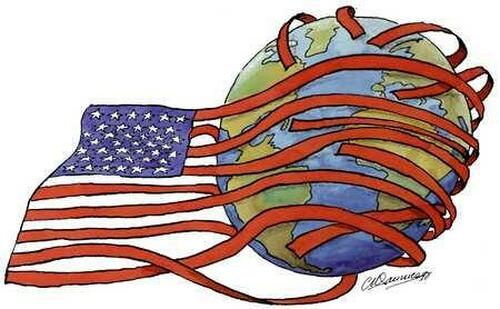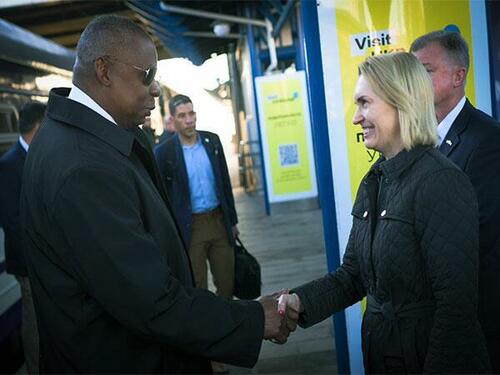The Left Falsely Portrays Disinformation As The Right’s Monopoly
Authored by Peter Berkowitz via RealClearPolitics,
On an Oct. 13 MSNBC broadcast with anchor Jen Psaki, Democratic strategist – and former political advisor to President Bill Clinton – James Carville denounced Donald Trump for putting “the entire Constitution in jeopardy.” Carville offered a concrete example of the right’s subversion of American freedom and democracy: “The Supreme Court and Clarence Thomas have totally greenlighted the idea that you could round up, use the military to round up your political enemies.” A former political advisor to Presidents Barack Obama and Joe Biden, Psaki replied with a smile, “We love the truth telling.”
Carville and Psaki are typical. The left often portrays itself as the rigorous defender of truth against relentless right-wing disinformation while resolutely promoting progressive disinformation, including the falsehood that disinformation is a distinctively right-wing phenomenon.
Small wonder that Carville did not elaborate on his extraordinary accusation, and that Psaki did not ask why he singled out Justice Thomas or how the Supreme Court authorized the rounding up of political enemies. Perhaps Carville had in mind the court’s holding last July in Trump v. United States “that the President is absolutely immune from criminal prosecution for conduct within his exclusive sphere of constitutional authority.” But the Constitution does not give the president authority to round up political enemies.
Did Carville glibly attack Trump and did Psaki politely play along? Did partisan rage distort Carville’s judgment as well as Psaki’s? Did Carville resolve to assert – and Psaki to endorse – whatever it takes, including nightmare scenarios, to protect democracy from Trump?
It is hard to read hearts and minds. But one can confidently affirm that deceiving about politics is as old as politics.
Circumstances change. Regimes come and go. Empires rise and fall. Parties win and lose. Yet even as modernization and technology revolutionize human affairs by generating material abundance, destabilizing settled expectations, and eroding inherited understandings, human beings remain social and political animals. Individuals need one another’s company and cooperation while – given diverse backgrounds, disposition, abilities, and interests – differing over what is useful, just, and good. Some strive to exercise power over others while most try to minimize the power that others exercise over them. Through it all, passion and prejudice constantly buffet everyone’s reasoning, and auspicious opportunities and dire predicaments tempt even the virtuous to portray the facts as other than they are.
No doubt novel opportunities abound today for promulgating lies and disseminating the family of departures from the truth that human beings routinely produce, distribute, consume, and rail against. In particular, the Internet, digital communications, and social media have facilitated the acquisition and transmission of immense amounts of information. This has greatly increased the quantity and accelerated the velocity of casual errors, self-deceptions, well-meaning half-truths, fraudulently marketed opinions and ideas, and outright lies that swirl through political culture.
Both right and left in America partake of the free-for-all of duplicity – often crude, occasionally artful – that plagues American politics. There is, however, an asymmetry.
Both sides insist that the other is exclusively at fault for the decay of public discourse. But the left controls the commanding heights of education, mainstream and social media, and government bureaucracy.
The left’s false contention that the right exercises a monopoly on manipulation, deceit, and falsehood is particularly damaging because the left amplifies its accusation through domination of the nation’s communication, elite opinion formation, and rule-making and law-enforcement institutions. This substantial advantage in the struggle to shape public opinion encourages the left’s sense of superiority while blinding progressives to their own intellectual subterfuges and ideological swindles. It also foments outrage on the right. Conservatives justify their extreme statements and outrageous claims as playing by progressives’ rules.
Atlantic staff writer Charlie Warzel recently illustrated the left’s propensity to wrongly present disinformation as a specifically right-wing pathology. Author of “Galaxy Brain,” The Atlantic’s newsletter “about technology, media, and big ideas,” Warzel argues in “I’m Running Out of Ways to Explain How Bad This Is” that an unprecedented assault on truth has “been building for more than a decade.” The crisis stems, he maintains, from a calamitous combination of right-wing extremism and digital technology that breaks reality into two – a world of truth inhabited by the left and a world of “dark” falsehoods that the right creates, outfits, and calls home.
“This reality-fracturing is the result of an information ecosystem that is dominated by platforms that offer financial and attentional incentives to lie and enrage, and to turn every tragedy and large event into a shameless content-creation opportunity,” writes Warzel. “This collides with a swath of people who would rather live in an alternate reality built on distrust and grievance than change their fundamental beliefs about the world.”
Warzel would have placed his analysis of just how badly political discourse in America has deteriorated on much sounder footing if he had recognized that the left also employs digital technology to fabricate and maintain a separate world. In the left’s alternative reality, the remorseless siege of systemic racism, sexism, and other sinister forms of oppression obliges progressives to abandon basic requirements of evidence and argument to rally the faithful and save the nation and the world.
Responses to Hurricanes Helene and Milton, maintains Warzel, have set a new low. “Even in a decade marred by online grifters, shameless politicians, and an alternative right-wing-media complex pushing anti-science fringe theories,” he writes, “the events of the past few weeks stand out for their depravity and nihilism.” He gives chilling examples careening around the Internet of harebrained conspiracy theories about government malfeasance and implausible stories of official neglect, or deliberate disregard, of storm victims that have delayed the delivery of essential government services. These remind that people can easily dupe others and be duped, especially when hurricane season coincides with election season, and individuals are armed with smart phones and social media accounts, and distrust elite institutions.
Warzel is rightly alarmed that “Americans are divided not just by political beliefs but by whether they believe in a shared reality – or desire one at all.” But his one-sided analysis inadvertently underscores that fault for the splintering of America does not lie solely with Trump and his backers.
Or even primarily.
Yes, Jan. 6, 2021, was a disgrace. Yes, right-wing rhetoric can be ridiculous, ominous, and vile. And yes, right-wing activists also exploit the Internet to stoke grievance and stir up resentment and rage.
Still, progressives tend to neglect that Trump and his voters have reasons, accumulating for decades, for distrusting institutions fundamental to the nation’s security, prosperity, and freedom and dominated by progressives: universities, the mainstream media and social media, and the federal bureaucracy.
Contrary to the common view on the left that Trump inaugurated a war on truth, our universities have for at least two generations sought to emancipate students from the traditional understanding that higher education’s purpose is to pursue knowledge and cultivate independent minds. Instead, through a succession of intellectual fashions and fads – including positivism, relativism, postmodernism, deconstruction, multiculturalism, identity politics, and intersectionality – universities have fostered the incoherent and partisan belief that since moral values are socially constructed, progressive policies must prevail.
Meanwhile, our progressive media – mainstream and social – and our progressive federal bureaucracy have collaborated to promote progressive national narratives by censoring opinions that challenge the progressive perspective and weaponizing the law against those who oppose progressivism’s hegemony.
The most egregious such collaboration revolved around the charge – widely presented as established fact by the press, defeated candidate Hillary Clinton, and elected Democratic officials and progressive intellectuals – that Donald Trump conspired with Russia to steal the 2016 election. This weighed down President Trump and hampered his administration. Yet after a two-year investigation, Special Counsel Robert Mueller, whose team contained several experienced and high-powered Democratic lawyers, issued a lengthy report stating that the investigation “did not establish that the Trump campaign coordinated with the Russian government in its election interference activities.”
Another disreputable collaboration to advance progressive ends sought to push Democratic presidential candidate Joe Biden over the finish line in November 2020. A few weeks before the election, the New York Post accurately reported that a laptop containing incriminating evidence belonged to Joe Biden’s son Hunter. The mainstream media, social media, and the FBI censored the Post’s reporting while disseminating the falsehood that the computer was a product of Russian disinformation.
A third major collaboration occurred during the COVID-19 pandemic. The New York Times and the Washington Post derided the notion that the virus leaked from a Chinese lab, which it likely did, and government officials, led by Dr. Anthony Fauci and Dr. Francis Collins, suppressed the lab-leak hypothesis. In addition, the mainstream media, social media, and federal government teamed up to discredit and silence those who raised questions about the efficacy of masks, lockdowns, and vaccines.
To do their share to arrest the splintering of America, progressives must do more than profess their love of the truth. They must act like they mean it.
Peter Berkowitz is the Tad and Dianne Taube senior fellow at the Hoover Institution, Stanford University. From 2019 to 2021, he served as director of the Policy Planning Staff at the U.S. State Department. His writings are posted at PeterBerkowitz.com and he can be followed on X @BerkowitzPeter.
Tyler Durden
Mon, 10/21/2024 – 23:25
via ZeroHedge News https://ift.tt/6mPGDxc Tyler Durden
















